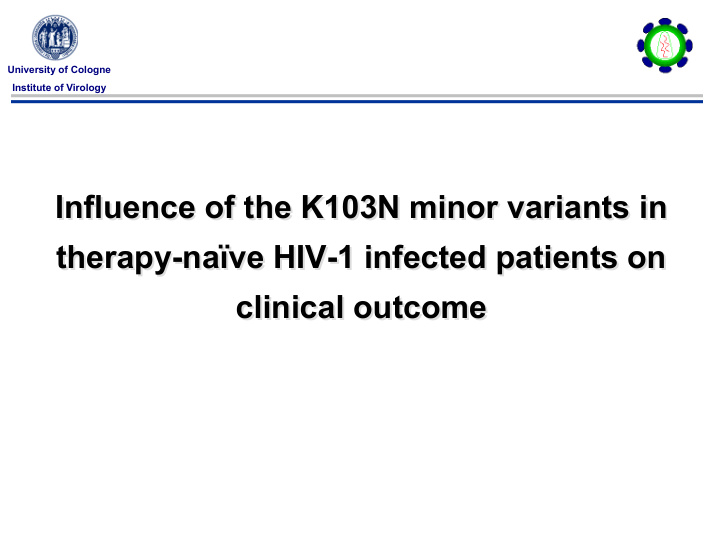



University of Cologne Institute of Virology Influence of the K103N minor variants in Influence of the K103N minor variants in therapy-naïve HIV-1 infected patients on therapy-naïve HIV-1 infected patients on clinical outcome clinical outcome
Why? Why? University of Cologne Institute of Virology …with the method of direct sequencing only virus populations ≥ 20% can be detected. …it is important to detect mutations as soon as possible to avoid early virological failure … to know more about evolution of viral strains under changing drug conditions (e.g treatment interruption or transmitted resistance). ….in drug classes with a low genetic barrier such as NNRTIs one mutation (e.g K103N) is enough for drug failure.
How? How? University of Cologne Institute of Virology quantification of the two different products with …with a real time assay on the LightCycler 2.0 (Roche) standard plasmids with Taqman- probes two different specific primerpairs modified method after Lecossier et al. (K103N) Calculation proportion of mutant (%)= first primerpair: equal amplification of mutant and wt K103N and K103 (amount of mutant / general amount) x 100 amplification X second primerpair: amplification of mutant and no amplification of wt X K103N K103 amp. no amp. X X
What? What? University of Cologne Institute of Virology RT K103N
K103N K103N University of Cologne Institute of Virology characteristics: common reverse transcriptase mutation against non-nucleosidic-reverse-transcriptase inhibitors (NNRTI) for this drug class with a very low genetic barrier one mutation is sufficient to cause drug failure reported by Lecossier et al. a minority population with a K103N can get dominant under a treatment with EFV or NVP and leads to inefficacy of these drugs
Patients´ characteristics Patients´ characteristics University of Cologne Institute of Virology 159 therapy naïve patients from the RESINA cohort 127 patients with HIV-1 subtype B, 32 non-B subtype 130 male, 29 female median time since infection: 0.25 years (range 0-18) VL 12 week after start of therapy available from 121 patients
Population based sequencing Population based sequencing University of Cologne Institute of Virology 18 16 number of mutations 14 12 10 8 6 4 2 0 NRTI-mutants revertant RT 215 NNRTI-mutants 108 I M41L 75 I, A 210 W 67 N 69 S 219 Q 101 E 103 R 181 C 230 T 118 C, F, G, V resistance associated mutations no K103N detectable 17 patients with NRTI associated mutations (10.7 %) 10 patients with a revertant at position 215 6 patients with NNRTI mutations (3.8%)
K103N Minority Assay K103N Minority Assay University of Cologne Institute of Virology Minority assay with a sensitivity of 0.2 % proven shows: 159 pats 127 pats. 32 pats. K103 wt K103N 20% minority resistance
Minority K103N Minority K103N University of Cologne Institute of Virology Prevalence of non-B subtypes 12 total 10 minority 8 patients 6 4 2 0 G J X A C E G D P A p A p p p p y C _ y _ y y y t F _ t F t t t b b b b b R R F u u u u u S R C S C S S S C Subtypen Higher frequency in non B subtypes 40.6% (13/32) Frequency in B subtype 15% (19/127)
Clinical outcome Clinical outcome University of Cologne Institute of Virology 121 patients were treated (38 patients no therapy or lost in follow up) NRTI backbone (64% AZT+ 3TC 26% TDF+ FTC 10% other) 34% 66% (41 pats.) (80 pats.) Non NNRTI treatment NNRTI 21% 79% fail success (17 pats.) (63 pats.) min K103N no min K103N fail success fail succ 32% 68% (13 pats.) (23 pats.) 24% 76% 15% 85% (4 pats.) (13 pats.) (9 pats.) (54 pats.)
Threshold of failure? Threshold of failure? University of Cologne Institute of Virology Proportion Treatment Proportion Treatment Patient nr. Patient nr. minority % failure minority % failure 14 0.20 29 0.32 23 0.20 + 26 0.33 25 0.20 9 0.33 8 0.21 12 0.33 17 0.21 30 0.33 32 0.21 13 0.34 18 0.22 31 0.34 24 0.22 + 15 0.36 + 6 0.23 27 0.41 10 0.23 7 0.47 21 0.23 22 0.52 1 0.23 20 2.41 28 0.24 16 3.20 2 0.25 3 8.62 4 0.26 19 13.00 + 11 0.30 5 0.31 no threshold for a minority amount and therapy failure can be found
Summary Summary University of Cologne Institute of Virology overall unexpected high prevalence of K103N in therapy- naïve patients of 20% was found Population based sequencing: 10.7 % NRTI mutations 3.8% NNRTI mutations no patient with minority harboured another major mutation difference in resistant minority populations K103N in HIV-1 subtype B (15%) vs. non B subtype (41%) Higher therapy failure rate in NNRTI-treated patients with minority than without minority (24% vs.15%), not significant No threshold of K103N minority and therapy failure could be found
University of Cologne Institute of Virology Jürgen Rockstroh Gerd Fätkenheuer Rolf Kaiser Mark Oette Martin Däumer and colleagues Saleta Sierra Dörte Hammerschmidt Ibrahim Boussaad Thank you Jens Verheyen Elena Knops Claudia Müller Resina study group Stephanie Koch Nadine Sichtig Arne Kroidl Herbert Pfister Susanna Trapp Monika Timmen-Wego
Recommend
More recommend